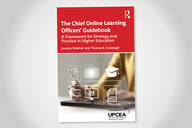You have /5 articles left.
Sign up for a free account or log in.
Are you part a MOOC at your school?
Have you taught, developed, TA’d, facilitated, designed, filmed, edited, assessed or communicated about an open online course at your college or university?
The most vocal opinions on MOOCs seem to belong to those who have never worked on a MOOC. Let’s give the practitioners a chance to talk about their experiences.
Here are 5 ways that I have observed how creating and teaching MOOCs can impact residential teaching and learning:
1. MOOCs Help Create a Space for Wide-Ranging Discussions About The Changing Higher Ed Landscape:
How often do a wide variety of educators come together on your campus to discuss the future of higher education? What opportunities do your faculty, students, leadership, and administrators have to discuss together what comes next in higher education? How often are contributions to these discussions based on passion and expertise, rather than rank and hierarchy?
The great gift of MOOCs for our campuses is not the actual open online courses, but rather in all the discussions that precede and surround any MOOC initiative.
Any discussion about MOOCs will inevitably lead to a discussion of issues around postsecondary access, costs, and quality.
Any discussion of MOOCs will bring up disagreements and divergent views on the evolving postsecondary competitive landscape.
My experience is that MOOCs enable of a more egalitarian, inclusive, and vibrant discussion of the future of higher education than normally occurs on campus.
2. MOOCs Provide An Opportunity to Rethink Introductory Classes:
The most important change going on right now in higher education is the widespread rethinking of the introductory course.
Every campus that I know of that is involved in open online education is also involved in initiatives aimed at introductory course redesign.
Courses designed around a pedagogical model of information transfer and content acquisition testing have been commoditized.
Across higher education there are important experiments going on to shift larger-enrollment introductory courses away from a lecture and test model, and towards methods that allow a more personalized mode of instruction.
This shift is enabled by new methods (flipped classes) and technologies (learning platforms), but also the growing awareness that high-priced residential courses must offer greater value than their free online equivalents.
3. MOOCs Accelerate the Development of a Team Approach to Course Development:
The transition from a lecture teaching to an active learning model for larger-enrollment courses is really difficult.
Anyone who has ever witnessed a poorly done flipped class knows a thing or two about unintended consequences.
A middling lecture is infinitely better than a poorly executed flipped class.
It is for these reasons that moving towards universal active learning requires so much work. The most effective route that I have witnessed to accomplish this transition to universal active learning is when faculty are surrounded by robust resources.
The goal should be to enable faculty to reach their teaching objectives (whatever they define) - and one method is to provide faculty with a team to help them reach their goals.
Imagine what residential courses could look like if the same resources need to create a high quality MOOC were made available. How much could faculty do with introductory courses if they had access to collaboration with a team of instructional designers, librarians, media educators, and assessment experts?
What MOOCs can do is shift how faculty think about the process of creating a course - opening up new ideas about how this process can shift from a purely solo effort to a more collaborative creative process.
4. MOOCs Create New Capabilities in Instructional Design and Educational Media:
What are the core capabilities at your institution? What are the skills that you think should never be sourced?
My argument is that anything to do with teaching (and research) should always stay local. Rent (source) everything else.
Creating a high quality MOOC (or a high quality low-residency or online course) requires an institution to have a range of capabilities. These capabilities include instructional design and the creation of media for learning.
The strategy that I like to follow is shamelessly exploit the need to develop capabilities in instructional design and media to benefit residential teaching and learning. Use instructional designers and media educators a little bit for MOOCs, and lots and lots for traditional residential courses.
5. MOOCs Support the Development of New Campus Skills in Assessment and Learning Research:
I worry about an overly enthusiastic focus on data and assessment in postsecondary learning. The history of assessment driven reform in our nation’s K-12 schools (No Child Left Behind) should be a cautionary tale for all of us in higher ed. And there is no doubt that learning analytics have been overhyped.
What I do think that MOOCs are helping us do is to bring a conversation about research and evidence into our instructional practices.
I’m less enamored with MOOC research that seeks to optimize the MOOC course, and more excited about developing the language and the capabilities to continuously improve our residential courses based on evidence about what is working.
All of us should be able to understand if our courses are serving all of our learners.
In figuring out how to assess our MOOC initiatives, we are developing new skills and a new vocabulary that we can apply to our residential courses.
Is this an overly optimistic view of the positive impact of MOOCs on residential learning?
What are the possible downsides to the campus experience of investing in MOOCs?
Are campus learning initiatives a zero sum game, with any dollar invested in open online learning now unavailable for residential teaching and learning? Or can MOOCs grow the learning resource and attention pie?
What has been your experience of how working on a MOOC has changed teaching and learning at your school?




